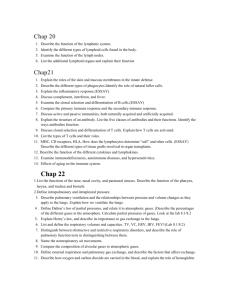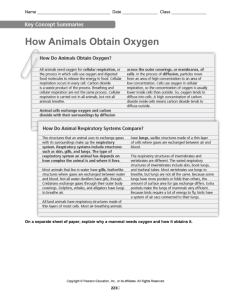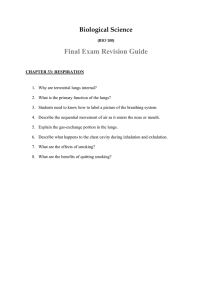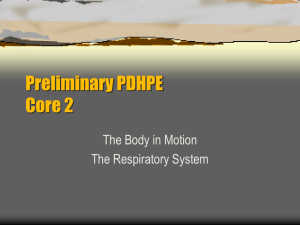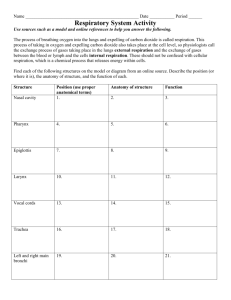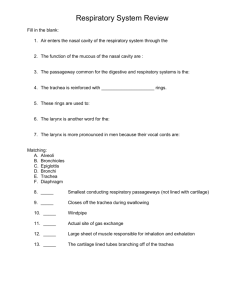respiratory system-L1 students 2012-2013
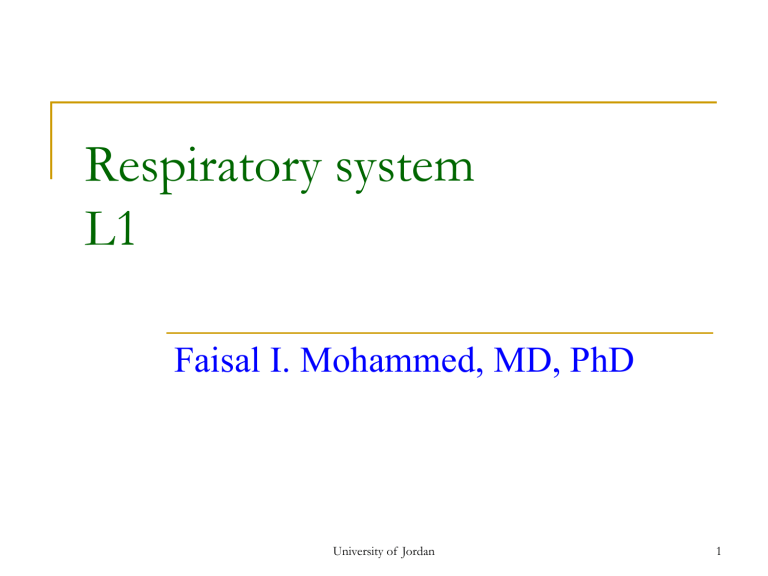
Respiratory system
L1
Faisal I. Mohammed, MD, PhD
University of Jordan 1
Recognize the Functions of the respiratory system.
Understand Mechanism of Inspiration and Expiration.
Recognize Surface tension and role of Surfactant.
Understand Pressure and Volume Changes During Breathing.
2
The objectives will be met through
I. Pulmonary ventilation *
1.Mechanisms of pulmonary ventilation
2.Indexes of pulmonary ventilation function
II. Pulmonary gas exchange and Tissue gas exchange
1. Principles of gas exchange *
2. Pulmonary gas exchange *
3. Tissue gas exchange
III. Gas transport in the Blood
1. Transport forms of oxygen and carbon dioxide in the blood
2. Oxygen transport *
3. Carbon dioxide transport *
IV. Respiratory Regulation
1. Respiratory centers and formation of respiratory rhythm
2. Reflex regulation of respiration *
V. Role of the lungs in regulation of acid-base balance
Overview of lung function and structure
Lung Functions
Lungs are a site for gas exchange with the external environment.
Regulate acid-base balance.
Lungs have a defense mechanism.
Lungs are a blood reservoir.
Serve a biosynthetic function (Angiotensin II, surfactant)
Respiratory component element
Respiration is the exchange of gas between the body and the environment.
External respiration : the exchange of gases between pulmonary blood and the external environment, which involves not only diffusion across the lung capillaries
( pulmonary gas exchange, but also the bulk movement of gases in and out of the lungs (pulmonary ventilation).
Internal respiration : the exchange of gases between the tissue cells and the systemic capillaries. The diffusion of gases between the interstitial fluid and the cytoplasm.
Gas transport in the blood : physical solvation and chemical constitution.
Structures of the Respiratory System
University of Jordan 6
University of Jordan 7
Respiratory Zone
Region of gas exchange between air and blood.
Includes respiratory bronchioles and alveolar sacs.
Must contain alveoli.
Conducting Zone
All the structures air passes through before reaching the respiratory zone.
Warms and humidifies inspired air.
Filters and cleans:
Mucus secreted to trap particles in the inspired air.
Mucus moved by cilia to be expectorated.
Insert fig. 16.5
Microscopic Anatomy of Lobule of Lungs
University of Jordan 10
Alveoli
Cup-shaped outpouching
Alveolar sac – 2 or more alveoli sharing a common opening
2 types of alveolar epithelial cells
Type I alveolar cells – form nearly continuous lining, more numerous than type II, main site of gas exchange
Type II alveolar cells (septal cells) – free surfaces contain microvilli, secrete alveolar fluid
(surfactant reduces tendency to collapse)
University of Jordan 11
Components of Alveolus
University of Jordan 12
Pneumocytes I and pneumocytes II
Pulmonary ventilation
1.
2.
3.
Respiration (gas exchange) steps
Pulmonary ventilation/ breathing
Inhalation and exhalation
Exchange of air between atmosphere and alveoli
External (pulmonary) respiration
Exchange of gases between alveoli and blood
Internal (tissue) respiration
Exchange of gases between systemic capillaries and tissue cells
Supplies cellular respiration (makes ATP)
University of Jordan 14
Inhalation/ inspiration
Pressure inside alveoli lust become lower than atmospheric pressure for air to flow into lungs
760 millimeters of mercury (mmHg) or 1 atmosphere (1 atm)
Achieved by increasing size of lungs
Boyle’s Law – pressure of a gas in a closed container is inversely proportional to the volume of the container
Inhalation – lungs must expand, increasing lung volume, decreasing pressure below atmospheric pressure
University of Jordan 15
Boyle’s Law
University of Jordan 16
Inhalation
Inhalation is active – Contraction of
Diaphragm – most important muscle of inhalation
Flattens, lowering dome when contracted
Responsible for 75% of air entering lungs during normal quiet breathing
External intercostals
Contraction elevates ribs
25% of air entering lungs during normal quiet breathing
Accessory muscles for deep, forceful inhalation
When thorax expands, parietal and visceral pleurae adhere tightly due to subatmospheric pressure and surface tension – pulled along with expanding thorax
As lung volume increases, alveolar (intrapulmonic) pressure drops
University of Jordan 17
Exhalation/ expiration
Pressure in lungs greater than atmospheric pressure
Normally passive – muscle relax instead of contract
Based on elastic recoil of chest wall and lungs from elastic fibers and surface tension of alveolar fluid
Diaphragm relaxes and become dome shaped
External intercostals relax and ribs drop down
Exhalation only active during forceful breathing
University of Jordan 18
Diaphragm is the main muscle of inspiration
Dome-shaped
Inspiration
Expiration
University of Jordan 22
University of Jordan 23
University of Jordan 24
Thank You
University of Jordan 25

